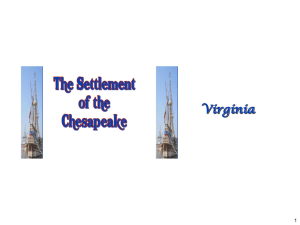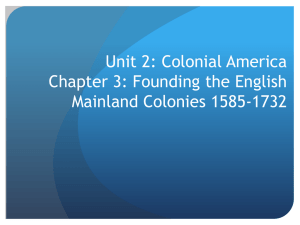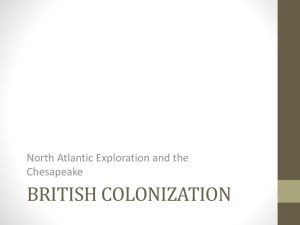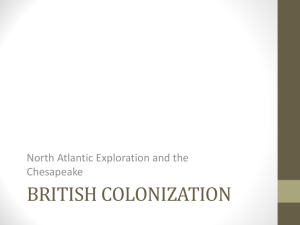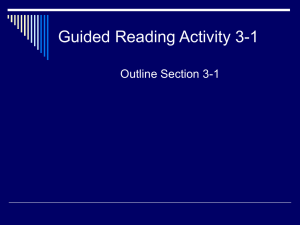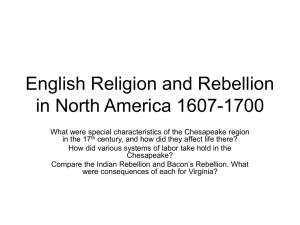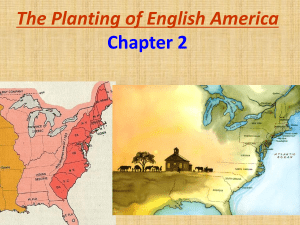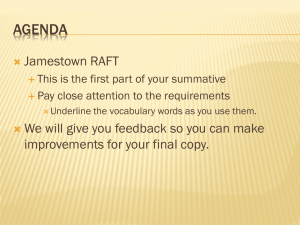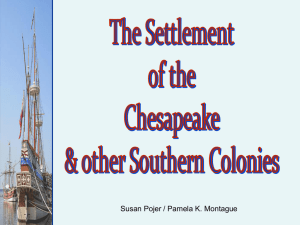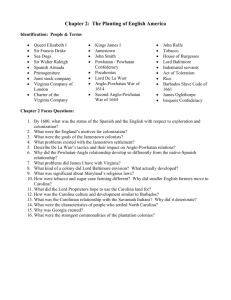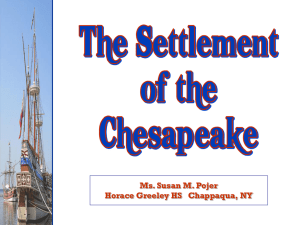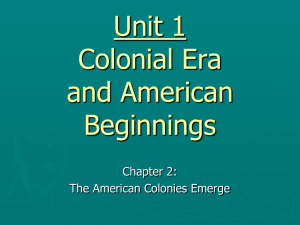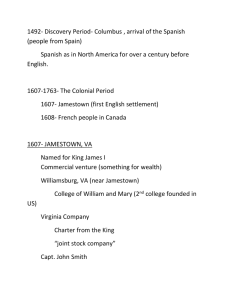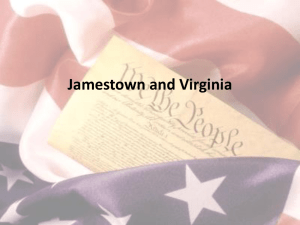ChesapeakeColonization (11-12)
advertisement
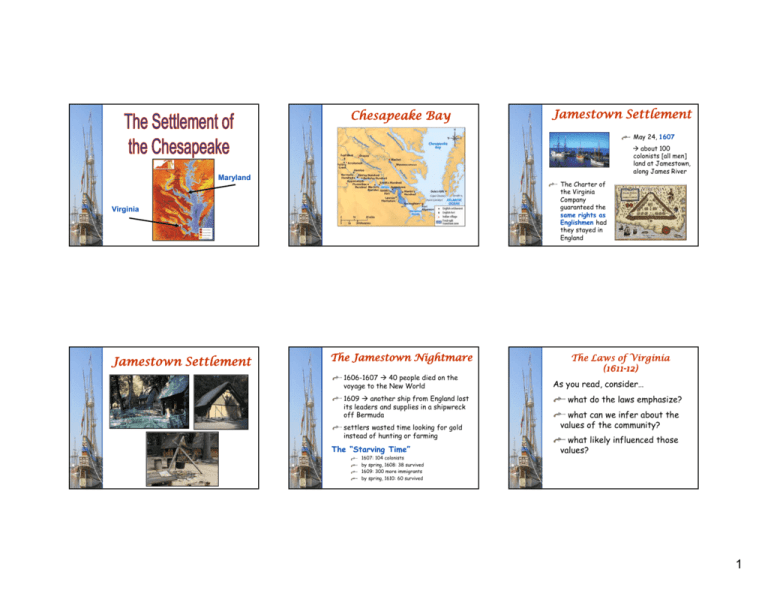
Chesapeake Bay Jamestown Settlement May 24, 1607 about 100 colonists [all men] land at Jamestown, along James River Maryland The Charter of the Virginia Company guaranteed the same rights as Englishmen had they stayed in England Virginia Jamestown Settlement The Jamestown Nightmare 1606-1607 40 people died on the voyage to the New World 1609 another ship from England lost its leaders and supplies in a shipwreck off Bermuda settlers wasted time looking for gold instead of hunting or farming The “Starving Time” The Laws of Virginia (1611(1611-12) As you read, consider… what do the laws emphasize? what can we infer about the values of the community? what likely influenced those values? 1607: 104 colonists by spring, 1608: 38 survived 1609: 300 more immigrants by spring, 1610: 60 survived 1 Captain John Smith: English Migration: 16101610-1660 The Right Man for the Job?? Jamestown Colonization Pattern: 16201620-1660 There was no talk…but dig gold, wash gold, refine gold, load gold… Pocahontas “saves” Captain John Smith High Mortality Rates Chief Powhatan Powhatan Confederacy 1610 – 1624: 10,000 immigrants 1624 population: 1,200 adult life expectancy: 40 years children that died before age five: 80% dominated a few dozen small tribes in the James River area probably saw the English as allies in his struggles to control other Indian tribes in the region Culture Clash in the Chesapeake Worsening Indian-settler relations general mistrust (cultures & languages) English raided Indian food supplies during the starving times 1610-1614 First Anglo-Powhatan War De La Warr had orders to make war on the Indians raided villages, burned houses, took supplies, burned cornfields 2 Culture Clash in the Chesapeake 1614-1622 peace! (briefly…) Powhatan Uprising of 1622 Culture Clash in the Chesapeake 1644-1646 Second Anglo-Powhatan War 1614 peace sealed by the marriage of Pocahontas to Englishman John Rolfe last effort of natives to defeat English Indians defeated again Peace Treaty of 1646 1622-1644 periodic attacks between Indians and settlers removed the Powhatans from their original land formally separated Indian and English settlement areas 1622 Powhatan Uprising killed 347 English [including John Rolfe] Virginia Co. called for a “perpetual war” against the Native Americans. sounds like ??? raids reduced native population and drove them further westward How did Jamestown prosper? Early Colonial Tobacco 1618 —20,000 pounds of tobacco produced 1622 —60,000 pounds of tobacco produced 1627 —500,000 pounds of tobacco produced 1629 —1,500,000 pounds of tobacco produced Tobacco Prices: 16181618-1710 Indentured Servitude Headright System: each Virginian got 50 acres for each person whose passage they paid Indenture Contract: 4-7 years Virginia’s gold and silver. -- John Rolfe, 1612 LongLong-term effects: chained VA’s economy to a single crop promised “freedom dues” [land, £] forbidden to marry 1610-1614: only 1 in 10 outlived their indentured contracts! need for cheap, abundant labor 3 Growing Political Power Why was 1619 a pivotal year for the Chesapeake settlement? House of Burgesses established in 1619 James I grew hostile to VA began to assume the role of the House of Commons (control over finances, militia, etc.) hated tobacco was able to initiate legislation by late 1600s a Council appointed by royal governor distrusted the House of Burgesses which he called a “seminary of sedition” 1624 he revoked the charter of the bankrupt VA Company mainly leading planters functions like House of Lords. high death rates ensured rapid turnover of members 17c Population in the Chesapeake English Tobacco Label Virginia Becomes a Royal Colony made into a royal colony (under the king’s direct control) The Atlantic Slave Trade 100000 80000 60000 White 40000 first Africans arrived in Jamestown in 1619 their status was not clear perhaps slaves OR indentured servants slavery not that important until late 1600s Black 20000 0 1607 1630 1650 1670 1690 WHY this large increase in black pop.? 4 Frustrated Freemen Colonial Slavery in the early 1600s, the differences between slave and servant were unclear *** slavery = economic institution by the mid-1680s, black slaves outnumbered white indentured servants, increasing white colonists’ fear of racial threat *** slavery = economic + racial institution made blacks (and children) property, or chattel for life Gov. Berkeley rebels resented Berkeley’s close relations with Indians rebels attacked all Indians, and drove Berkeley driven from Jamestown Nathaniel Bacon’s Rebellion 1676 they burned the capital and went on a rampage of plundering Bacon suddenly died of fever Berkeley brutally crushed the rebellion Results of Bacon’s Rebellion upper class planters searched for laborers less likely to rebel Nathaniel Bacon’s Rebellion: 1676 1670 the Virginia Assembly disenfranchised most landless men led 1,000 Virginians in a rebellion against Governor Berkeley “Slave Codes” began in 1662 exposed resentments between inland frontiersmen and landless former servants against gentry on coastal plantations late 1600s large numbers of young, poor, single, discontented men in the Chesapeake area class warfare white solidarity Practice Question Which of the following accurately describes a problem faced by Virginia in the last decades of the 17th century? A. a decline in the tobacco production B. frequent slave uprisings C. the lowering of wages caused by an influx of immigrants D. political control by small farmers in the House of Burgesses E. conflict between large plantation owners and settlers on Virginia’s western frontier The Settlement of Maryland a proprietary colony, created in 1634 George Calvert, Lord Baltimore, in 1632 5 St Mary’s City (1634) healthier location than Jamestown tobacco = main crop Lord Baltimore’s plan planned to govern as an absentee proprietor in a feudal relationship huge tracts of land granted to his Catholic relatives Catholic land barons surrounded by mostly Protestant small farmers conflict between barons and farmers led to Baltimore losing proprietary rights at the end of the 17th C. A Haven for Catholics A Haven for Catholics colonists received modest farms around the Chesapeake area Baltimore permitted freedom of worship to protect Catholics, but then Protestants felt threatened Catholic land barons surrounded by mostly Protestant small farmers conflict between barons and farmers led to Baltimore losing proprietary rights at the end of the 1600s by late 1600s, black slaves began to be imported Toleration Act of 1649 guaranteed toleration to all CHRISTIANS decreed death to those who denied the divinity of Jesus [like Jews, atheists, etc.] less tolerant than prior to the act The Toleration Act of 1649 ...whatsoever person or persons shall from henceforth upon any occasion of offence otherwise in a reproachfull manner or way declare call or denominate any person or persons whatsoever inhabiting, residing, traficking, trading or comercing within this province or within any ports, harbours, creeks or havens to the same belonging, an Heretick, Schismatick, Idolator, Puritan, Independent Presbyterian, Antenomian, Barrowist, Roundhead, Separatist, Popish Priest, Jesuit, Jesuited Papist, Lutheran, Calvenist, Anabaptist, Brownist or any other name or term in a reproachful manner relating to matters of Religion shall for every such offence foreit and lose the sum of ten shillings Sterling or the value thereof to be levied on the goods and chattels of every such offender and offenders... and if they could not pay, they were to be "publickly whipt and imprisoned without bail" until "he, she, or they shall satisfy the party so offended or grieved by such reproachful language...." 6

